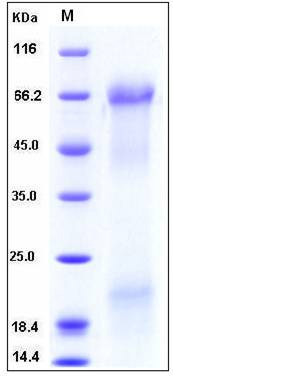Human Osteopontin / SPP1 / ETA-1 Protein (His Tag)
BNSP,BSPI,ETA-1,OPN
- 100ug (NPP4133) Please inquiry
| Catalog Number | P10352-H08H |
|---|---|
| Organism Species | Human |
| Host | Human Cells |
| Synonyms | BNSP,BSPI,ETA-1,OPN |
| Molecular Weight | The recombinant human SPP1 consists of 309 amino acids after removal of the signal peptide and has a calculated molecular mass of 35 kDa. The apparent molecular mass of rh SPP1 is approximately 60-65 kDa in SDS-PAGE under reducing conditions due to glycosylation. |
| predicted N | Ile 17 |
| SDS-PAGE |  |
| Purity | > 80 % as determined by SDS-PAGE |
| Protein Construction | A DNA sequence encoding the pro form of human SPP1 (NP_001035147.1) (Met 1-Asn 314) was fused with a polyhistidine tag at the C-terminus. |
| Bio-activity | Measured by the ability of the immobilized protein to support the adhesion of HEK293 human embryonic kidney cells. When cells are added to coated plates(2μg/mL, 100μL/well), approximately 60% will adhere after 1 hour of incubation at 37℃. |
| Research Area | Developmental Biology |Organogenesis |Excretory system development |Renal Markers |
| Formulation | Lyophilized from sterile PBS, pH 7.4 1. Normally 5 % - 8 % trehalose, mannitol and 0.01% Tween80 are added as protectants before lyophilization. Specific concentrations are included in the hardcopy of COA. |
| Background | Osteopontin, also known as Secreted phosphoprotein 1, Bone sialoprotein 1, BSP-1, OPN, and SPP1, is a member of the osteopontin family and a SIBLING glycoprotein. Osteopontin has been classified as T-helper 1 cytokine and thus believed to exacerbate inflammation in several chronic inflammatory diseases, including atherosclerosis. Besides proinflammatory functions, physiologically Osteopontin is a potent inhibitor of mineralization, it prevents ectopic calcium deposits and is a potent inducible inhibitor of vascular calcification. Osteopontin is expressed and secreted by various cells, and has a role in cell adhesion, chemotaxis, prevention of apoptosis, invasion, migration and anchorage-independent growth of tumor cells. Osteopontin recruitment functions of inflammatory cells are thought to be mediated through its adhesive domains, especially the arginine-glycine-aspartate (RGD) sequence that interacts with several integrin heterodimers. Osteopontin has emerged as a potential biomarker and mediator in cardiovascular disease. In the context of atherosclerosis, OPN is generally regarded as a proinflammatory and proatherogenic molecule. However, the role of OPN in vascular calcification (VC), which is closely related to chronic and active inflammation, is that of a negative regulator because it is an inhibitor of calcification and an active inducer of decalcification. Extensive research has demonstrated the pivotal participation of Osteopontin in the regulation of cell signaling which controls neoplastic and malignant transformation. The elevated expression of Osteopontin has been observed in a variety of cancers. It has been linked with tumor metastasis and signifies a poor prognosis for the patient. |
| Reference |
